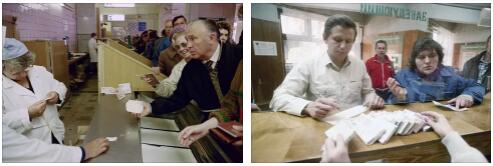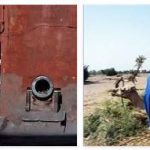The Russian economic system underwent a tumultuous evolution in the 1990s, with contradictory aspects: on the one hand, a process of liberalization, privatization and rationalization of the production structures was decisively initiated; on the other hand, profoundly negative phenomena have occurred, shown both by the bad trend of macroeconomic indicators and by the spread of elements of disorganization, social imbalance, corruption and real economic crime. Thus, the contribution of the private sector to the formation of official GDP has quintupled (reaching 70 % of the total, with peaks close to 100 % in the commercial sector), and that to total employment has doubled (exceeding 35 %) between the 1990and 1995, continuing this trend in the following years. At the same time, however, despite massive Western financial aid (and actual investments, but to a much lesser extent), material production (both in the rural and industrial economies) has significantly decreased, further lowering the already modest productivity.
The regional variations in this economic system which is in a state of great fluidity are noteworthy: the degree of privatization varies considerably from province to province, depending on the policies adopted by local authorities; There are also free zones on the outskirts of the country (Kaliningrad, Far Eastern Siberia, Sakhalin, etc.), completely open to foreign investors.
In the immense and inhospitable Russian space, agriculture in the strict sense – a sector in which privatization proceeds very slowly, due to the low propensity to entrepreneurship of the rural population for some time addicted to collectivism – continues to occupy only a small part (between 7 and 8%, especially the ‘black lands’, between the forest and the steppe) of the total area, mainly used for cereals, weeding and oil plants as well as textile plants. Thus, despite a series of bad harvests (which forced the country to an expensive resumption of imports of cereals from abroad), Russia remains firmly the first absolute world producer of barley and oats, among the very first of rye and potatoes and one of the first for wheat, as well as a decent producer of beet sugar, sunflower oil, flax and hemp. Vegetables (first of all cabbages) should not be forgotten, a traditional private crop under all regimes.
Another 5 % of the Russian land area is held, in the steppe belt, for fodder and pastures, on which (but also in the family stables) lives a substantial livestock, cattle and pigs and, to a lesser extent, sheep, moreover in very strong numerical decrease in recent years. Extensive, however, the forest area (substantially coinciding with the taiga), about 45% of the total, from which one of the most important timber productions in the world derives (but it is also decreasing) and to which a vast industrial sector is connected, which has the paper and furniture industry as its arrival points. Fishing is also important, both maritime (the Russia has lost many former Soviet coasts, but not the fish-rich Murmana coast and the Pacific coast) and fluvial (lower Volga).
From the Russian subsoil, notoriously rich in resources, minerals of all kinds continue to be extracted, in large quantities (but generally decreasing, also due to timid attempts at rationalization, closure of marginal deposits and elimination of the main diseconomies). Russia remains among the world’s largest producers of energy minerals (coal, lignite, oil, uranium) and the absolute first for natural gas (more than a quarter of world production), a leading player in perhaps the most dynamic and promising sector of the whole Russian economy. Russia occupies excellent positions, in the world rankings, also for the extraction of ordinary and precious metals (iron, gold, etc.). Frequent technical obsolescence, the need for investments, the search for outlets are the main current problems of the sector,
The production of electricity, also in decline but still fourth in the world, derives for the most part from traditional thermal power stations; the contribution of water plants follows in importance, while nuclear power contributes about 10 % of the total. Among the numerous nuclear power plants, some, such as those of Sosnovyj Bor (near St. Petersburg), Smolensk and Kursk seem decidedly at risk, at least according to Western safety standards, and projects for their modernization or rehabilitation are very slow; more generally, environmental pollution reaches very high levels in Russia, in most industrial areas.
The massive productive apparatus of the Russian industry – in which privatization is advancing, amidst deaf resistance in the most diverse environments, but in many cases it is only a facade operation and limited to some sectors – continues to provide very important productions especially in the branches of base, however quantitatively stationary or more often decreasing (steel, cement, sulfuric acid): the same technical, economic and financial problems already reported for mining recur. Production stagnation, persistent technological and organizational backwardness, as well as reluctance towards the necessary restructuring, characterize the entire manufacturing sector with few variations. There are some positive exceptions in the industries producing consumer goods.
A more brilliant evolution seems to characterize the tertiary sector which had remained compressed for so long in the past. Retail trade and services, the prices of which were liberalized as early as 1991- albeit with subsequent steps backwards – are now largely privatized (in Moscow in their entirety). Foreign trade develops – also because it started from very modest levels – at high growth rates; more than half of exports, however, continue to be represented by the classic item ‘minerals and metals’. The Russia tries in every way to maintain – and to increase with new pipeline projects – its fruitful control over the growing and promising exports of hydrocarbons from the Caspian Sea and from the Central Asian countries of the CIS. Despite everything, the trade balance is constantly positive, and the partners are rapidly diversifying: now four-fifths of the exchanges (in value) are made outside the CIS.








